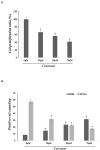Therapeutic targets and functions of curcumol against COVID-19 and colon adenocarcinoma
- PMID: 35967794
- PMCID: PMC9372556
- DOI: 10.3389/fnut.2022.961697
Therapeutic targets and functions of curcumol against COVID-19 and colon adenocarcinoma
Abstract
Since 2019, the coronavirus disease (COVID-19) has caused 6,319,395 deaths worldwide. Although the COVID-19 vaccine is currently available, the latest variant of the virus, Omicron, spreads more easily than earlier strains, and its mortality rate is still high in patients with chronic diseases, especially cancer patients. So, identifying a novel compound for COVID-19 treatment could help reduce the lethal rate of the viral infection in patients with cancer. This study applied network pharmacology and systematic bioinformatics analysis to determine the possible use of curcumol for treating colon adenocarcinoma (COAD) in patients infected with COVID-19. Our results showed that COVID-19 and COAD in patients shared a cluster of genes commonly deregulated by curcumol. The clinical pathological analyses demonstrated that the expression of gamma-aminobutyric acid receptor subunit delta (GABRD) was associated with the patients' hazard ratio. More importantly, the high expression of GABRD was associated with poor survival rates and the late stages of COAD in patients. The network pharmacology result identified seven-core targets, including solute carrier family 6 member 3, gamma-aminobutyric acid receptor subunit pi, butyrylcholinesterase, cytochrome P450 3A4, 17-beta-hydroxysteroid dehydrogenase type 2, progesterone receptor, and GABRD of curcumol for treating patients with COVID-19 and COAD. The bioinformatic analysis further highlighted their importance in the biological processes and molecular functions in gland development, inflammation, retinol, and steroid metabolism. The findings of this study suggest that curcumol could be an alternative compound for treating patients with COVID-19 and COAD.
Keywords: COVID-19; bioinformatics; biological functions; colon adenocarcinoma; curcumol; pharmaceutics targets.
Copyright © 2022 Li, Peng and Lai.
Conflict of interest statement
The authors declare that the research was conducted in the absence of any commercial or financial relationships that could be construed as a potential conflict of interest.
Figures




Similar articles
-
Network Pharmacology and Comparative Transcriptome Reveals Biotargets and Mechanisms of Curcumol Treating Lung Adenocarcinoma Patients With COVID-19.Front Nutr. 2022 Apr 19;9:870370. doi: 10.3389/fnut.2022.870370. eCollection 2022. Front Nutr. 2022. PMID: 35520289 Free PMC article.
-
Enhanced expression of GABRD predicts poor prognosis in patients with colon adenocarcinoma.Transl Oncol. 2020 Dec;13(12):100861. doi: 10.1016/j.tranon.2020.100861. Epub 2020 Sep 3. Transl Oncol. 2020. PMID: 32891902 Free PMC article.
-
Potential therapeutic strategies for quercetin targeting critical pathological mechanisms associated with colon adenocarcinoma and COVID-19.Front Pharmacol. 2022 Sep 29;13:988153. doi: 10.3389/fphar.2022.988153. eCollection 2022. Front Pharmacol. 2022. PMID: 36249762 Free PMC article.
-
Puerarin: A Potential Therapeutic for Colon Adenocarcinoma (COAD) Patients Suffering From SARS-CoV-2 Infection.Front Pharmacol. 2022 May 23;13:921517. doi: 10.3389/fphar.2022.921517. eCollection 2022. Front Pharmacol. 2022. PMID: 35677450 Free PMC article.
-
Distinct diagnostic and prognostic values of γ-aminobutyric acid type A receptor family genes in patients with colon adenocarcinoma.Oncol Lett. 2020 Jul;20(1):275-291. doi: 10.3892/ol.2020.11573. Epub 2020 Apr 24. Oncol Lett. 2020. PMID: 32565954 Free PMC article.
Cited by
-
Curcumol: a review of its pharmacology, pharmacokinetics, drug delivery systems, structure-activity relationships, and potential applications.Inflammopharmacology. 2024 Jun;32(3):1659-1704. doi: 10.1007/s10787-024-01447-6. Epub 2024 Mar 23. Inflammopharmacology. 2024. PMID: 38520574 Review.
References
-
- Semenzato L, Botton J, Drouin J, Cuenot F, Dray-Spira R, Weill A, et al. . Chronic diseases, health conditions and risk of COVID-19-related hospitalization and in-hospital mortality during the first wave of the epidemic in France: a cohort study of 66 million people. Lancet Reg Health Eur. (2021) 8:100158. 10.1016/j.lanepe.2021.100158 - DOI - PMC - PubMed
LinkOut - more resources
Full Text Sources
Research Materials
Miscellaneous

